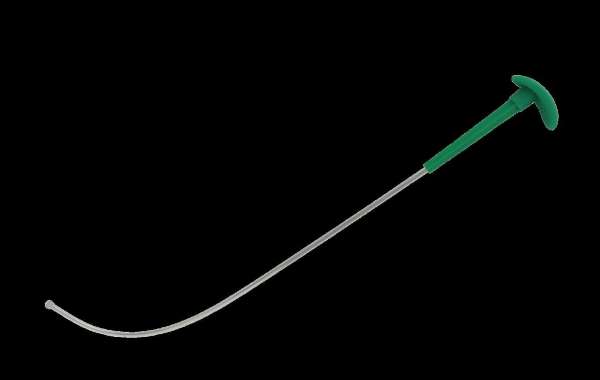In the fast-paced world of modern medicine, clinicians are constantly seeking ways to enhance patient care, reduce risks, and improve the efficiency of medical procedures. One tool that has proven to offer significant advantages in airway management is the single-use intubation stylet. This flexible device, designed to help guide endotracheal tubes (ETT) during intubation, has become an indispensable asset in clinical practice, particularly in critical care and emergency situations.
In this article, we will take a closer look at the single-use intubation stylet, exploring its key benefits for clinicians and how it enhances patient care and safety in various medical settings.
What is a Single Use Intubation Stylet?
A single-use intubation stylet is a disposable, malleable device that is used to assist with the placement of an endotracheal tube into a patient’s trachea during intubation. Its primary role is to provide rigidity and shape to the endotracheal tube, making it easier for clinicians to navigate the tube through the patient’s airway. The stylet can be bent and shaped to fit the specific anatomy of the patient, allowing clinicians to achieve a precise and controlled insertion.
What makes the single-use stylet distinct is its design for one-time use. After the procedure, the stylet is discarded, which eliminates the need for cleaning and sterilization, and ensures that each patient receives a fresh, sterile device.
Benefits of Single Use Intubation Stylets for Clinicians
- Improved Infection Control:
One of the greatest advantages of the single-use intubation stylet is its ability to reduce the risk of cross-contamination and infection transmission. Reusable intubation stylets require thorough cleaning and sterilization between uses, but even with stringent protocols, there is always a risk that pathogens could be transferred from one patient to another. In busy clinical environments, ensuring that reusable equipment is properly sterilized can sometimes be challenging.
With single-use stylets, this risk is virtually eliminated. Since each stylet is disposed of after use, there is no need for cleaning or sterilizing between procedures. This means that clinicians can be confident that each device is sterile and ready for immediate use, significantly reducing the likelihood of hospital-acquired infections (HAIs), which can be costly and harmful to patients.
- Enhanced Efficiency and Time Savings:
In medical settings—particularly in emergency care, intensive care, or the operating room—time is often a critical factor in patient care. Single-use intubation stylets offer significant time savings for clinicians by eliminating the need for cleaning, sterilization, and equipment maintenance associated with reusable stylets.
In emergency situations where intubation is required immediately, the single-use stylet provides a sterile, ready-to-use solution that can be swiftly implemented without delay. This allows clinicians to focus on the patient rather than worry about sterilizing equipment or waiting for reusable devices to be prepared. In addition, single-use stylets can help streamline the workflow in busy hospitals, where quick access to properly sterilized equipment is essential for maintaining efficiency.
- Consistency and Reliability:
For clinicians, the consistency and reliability of medical tools are essential to ensuring patient safety and successful outcomes. Over time, reusable intubation stylets can wear down, become bent, or degrade in some way, leading to potential complications during the intubation procedure. A damaged or malfunctioning stylet can hinder the process, making it difficult to guide the endotracheal tube through the patient’s airway and possibly resulting in prolonged intubation times or failed attempts.
With single-use intubation stylets, clinicians can rely on each device being in pristine condition. Every stylet is disposable, pre-sterilized, and brand new, which means that it is free from defects and performs at optimal levels every time. This provides clinicians with peace of mind, knowing that each intubation will be carried out with a high-quality device that functions as intended.
- Increased Patient Safety:
The safety of patients is a top priority for any healthcare provider, and the single-use intubation stylet plays a key role in improving patient outcomes during intubation procedures. Airway management is one of the most critical aspects of patient care, and incorrect placement of the endotracheal tube can lead to serious complications such as esophageal intubation, trauma to the airway, or hypoxia.
By ensuring that each intubation stylet is new, flexible, and in perfect condition, clinicians are better equipped to perform the procedure quickly and accurately. The malleability of the single-use stylet allows it to be shaped to the patient’s anatomy, enabling more precise placement of the endotracheal tube. The ability to control the tube during insertion reduces the chances of complications and ultimately enhances patient safety.
- Cost-Effectiveness in the Long Term:
Although single-use devices may appear to be more expensive initially, they can actually provide cost savings for healthcare facilities in the long run. When considering the costs of cleaning, sterilizing, and maintaining reusable devices, the expense of purchasing new, single-use stylets may be offset by the reduction in labor costs and the risk of equipment-related errors.
Additionally, infection-related complications that may arise from reusable devices (due to improper sterilization) can result in longer hospital stays, higher medical bills, and poor patient outcomes. The use of single-use stylets helps mitigate these risks, potentially saving healthcare systems substantial amounts in the form of reduced hospital-acquired infection rates and associated treatment costs.
- Flexibility for Difficult Airway Management:
In cases of difficult intubation, such as those encountered with trauma patients, patients with anatomical variations, or those with swelling or obstructions in the airway, a flexible intubation stylet is essential for ensuring successful airway management. Single-use intubation stylets are often highly malleable, allowing clinicians to customize the shape of the stylet to better fit the patient’s specific airway anatomy.
This flexibility allows the clinician to better maneuver the endotracheal tube through challenging airways and reduces the time spent in securing the tube. In emergency situations or during complex surgeries, the ability to quickly adapt to changing circumstances with a reliable tool can make a significant difference in patient outcomes.
- Simplified Logistics and Reduced Risk of Errors:
The use of single-use devices eliminates the need to track and manage reusable equipment. Reusable stylets require regular checks for wear and tear, proper sterilization, and organized storage, which can be logistically challenging in fast-paced clinical settings. Single-use stylets, on the other hand, simplify inventory management and ensure that clinicians have easy access to sterile, ready-to-use equipment whenever they need it.
This simplicity reduces the chances of human error related to equipment preparation, contamination, or malfunction, further enhancing the safety of the intubation procedure.
Conclusion:
The single-use intubation stylet offers numerous benefits to clinicians in various healthcare settings, from emergency care to intensive care and routine surgeries. By improving infection control, streamlining workflows, enhancing patient safety, and ensuring the reliability of intubation procedures, this disposable device has become a crucial tool in modern airway management.
Clinicians can be confident in their ability to secure a patient's airway quickly and effectively, knowing that each single-use stylet will be in optimal condition for the procedure. In a world where patient safety and efficiency are paramount, the single-use intubation stylet stands out as an essential tool for improving patient outcomes and supporting the clinical team in delivering high-quality care.






